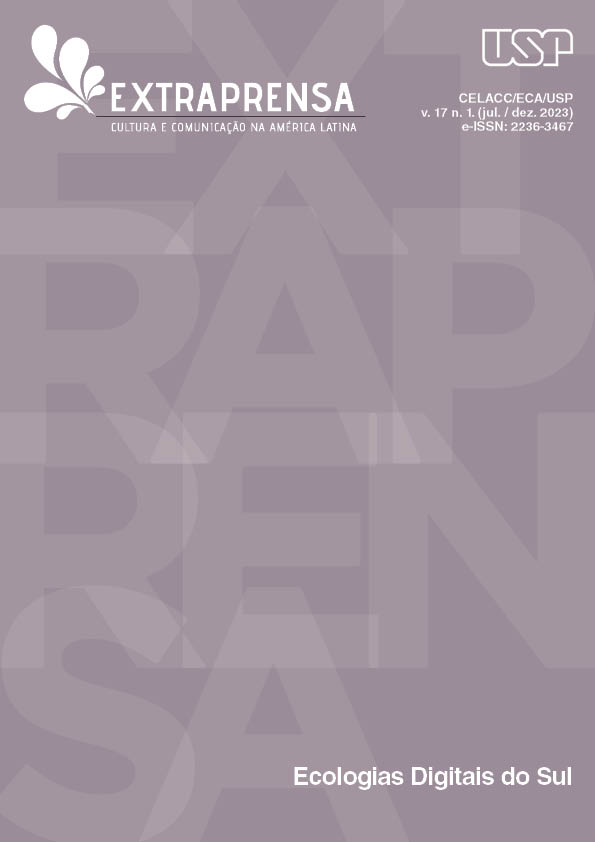Digital humanities in Alaic, Compós and Intercom research (2019-2022)
DOI:
https://doi.org/10.11606/extraprensa2024.217162Keywords:
Communication, Digital humanities , Methodology , SearchAbstract
This paper seeks to understand how Digital Humanities (DH) has approached the field of Communication. Thus, the justification for this research is based on the fact that the area of Communication, as well as that of DH, has grown exponentially, especially in its epistemological roots and the concretization of the field as important areas of knowledge. Thus, the general objective of this work is to present the state of the art of HD within the field of Communication. To this end, we analyzed analogically, i.e. manually, three academic data platforms of events in the field of Communication knowledge, namely Compós, Revista Intercom (Intercom) and Alaic, from January 1, 2019 to December 31, 2022. Once we had the data, we analyzed the findings, highlighted two digital tools and concluded the work by recognizing that HD can collaborate with Communication research, but that it still needs to be understood and applied in the research methodologies it adopts.
Downloads
References
ALAIC. Quem somos? Disponível em: https://alaic.org/pt/quienes-somos/. Acesso em: 15 ago. 2023.
BORGES, Gabriela. Desafios da formação em competência midiática no Observatório da Qualidade no Audiovisual. Chasqui. Revista Latinoamericana de Comunicacion, Ecuador, nº 146, p. 217-234, abr./jul, 202. Disponível em: https://www.academia.edu/86683930/Desafios_da_forma%C3%A7%C3%A3o_em_compet%C3%AAncia_midi%C3%A1tica_no_Observat%C3%B3rio_da_Quallidade_no_Audiovisual. Acesso em: 10 jul. 2023.
BARBOSA, Marinalva Carlos. A pluralidade de modelos interpretativos nas ciências humanas e o lugar da Comunicação. In: Pesquisa em Comunicação: metodologias e práticas acadêmicas. Org. Cláudia Peixoto de Moura, Maria Immacolata Vassallo de Lopes. Porto Alegre: EDIPUCRS, p. 195-211, 2016.
CARR, Nicholas. The Shallows: What the Internet Is Doing to Our Brains. New York: W.W. Norton & Company, 2011.
COMPÓS. A Compós. Disponível em: https://compos.org.br/a-compos/. Acesso em: 15 ago. 2023
CRARY, Jonathan. 24/7 - Capitalismo tardio e os fins do sono. São Paulo: Cosac Naify, 2014.
GONZALEZ DE GOMEZ, M. N. A Ciência da Informação no cruzamento de fronteiras. In: ENCONTRO DA ASSOCIAÇÃO DE EDUCAÇÃO E PESQUISA EM CIÊNCIA DA INFORMAÇÃO DA IBERO-AMÉRICA E CARIBE (EDICIC), 10, Belo Horizonte, 2016. Anais. Belo Horizonte: ECI/UFMG, 2017. p. 35-61.
HALL, Stuart. A identidade cultural na pós-modernidade. Tradução: Tomaz Tadeu da Silva & Guaciara Lopes Louro. Rio de Janeiro: Lamparina, 2014.
INTERCOM. A Intercom. Disponível em: https://www.portalintercom.org.br/a-intercom. Acesso em: 15 ago. 2023.
KIRSCHENBAUM, M. G. What is digital humanities and what's it doing in english departments? ADE Bulletin, v. 150, n. 7, p. 55-61, 2010. Disponível em: Disponível em: https://www.ade.mla.org/content/download/7914/225677. Acesso em: 15 ago. 2023.
MASSARANI, L. M. ET ALI. A pandemia de COVID-19 no Youtube: Ciência, Entretenimento e negacionismo. Disponível em: Acesso em: 15 ago. 2023.
MOURA, Maria Aparecida. Ciência da Informação e humanidades digitais: mediações, agência e compartilhamento de saberes. Perspectivas Em Ciência Da Informação, 24 (spe), 57–69, 2019. Disponível em: https://www.scielo.br/j/pci/a/GzKTfV7D4s7RLMM6qgpHkJF/abstract/?lang=pt#. Acesso em: 10 jul. 2023.
SANTOS, B. de S. Um discurso sobre as ciências. São Paulo: Cortez, 2004.
SEMRUSH. O que é Google Trends e como usar para pesquisa de palavras. Disponível em: https://pt.semrush.com/blog/google-trends/. Acesso em: 15 ago. 2023
SILVA, Cláudio José Ribeiro; HIGUCHI, Suemi; COELHO, Luis Antoni Ferla. Aproximações ao cenário das humanidades digitais no Brasil. Digital Humanities Quarterly; Providence Vol. 14, Iss. 2, 2020.
SOUSA. S. M. DE. A transmidialidade como estratégia discursiva. Disponível em: https://periodicos.fclar.unesp.br/casa/article/view/8015/5850. Acesso em: 15 ago. 2023.
STILINGUE. SNLP: descubra o motor de Processamento de Linguagem Natural da STILINGUE. Disponível em: https://blog.stilingue.com.br/ia-nlp/snlp-descubra-o-motor-de-processamento-de-linguagem-natural-da-stilingue/. Acesso em: 15 ago. 2023.
VIEIRA, E.S. ET ALI. Muito além da ficção televisiva: Stranger Things e as estratégias de engajamento das indústrias do entretenimento. Disponível em: http://revista.pubalaic.org/index.php/alaic/article/view/894/890. Acesso em: 15 ago. 2023.
VOYANT. Voyant Tools: Pesquisa HD. Disponível em: https://voyant-tools.org/?corpus=ad4d20439a42db1cee22f2f1edf42494. Acesso em: 15 ago. 2023.
Downloads
Published
Issue
Section
License
Copyright (c) 2023 Fernanda Sevarolli Creston Faria, Marco Aurélio Kistemann Junior

This work is licensed under a Creative Commons Attribution-NonCommercial-NoDerivatives 4.0 International License.
Ao submeter qualquer material científico para Extraprensa, o autor, doravante criador, aceita licenciar seu trabalho dentro das atribuições do Creative Commons, na qual seu trabalho pode ser acessado e citado por outro autor em um eventual trabalho, porém obriga a manutenção de todos os autores que compõem a obra integral, inclusive aqueles que serviram de base para o primeiro.
Toda obra aqui publicada encontra-se titulada sob as seguintes categorias da Licença Creative Commons (by/nc/nd):
- Atribuição (de todos os autores que compõem a obra);
- Uso não comercial em quaisquer hipóteses;
- Proibição de obras derivadas (o trabalho não poderá ser reescrito por terceiros. Apenas textos originais são considerados);
- Distribuição, exibição e cópia ilimitada por qualquer meio, desde que nenhum custo financeiro seja repassado.
Em nenhuma ocasião a licença de Extraprensa poderá ser revertida para outro padrão, exceto uma nova atualização do sistema Creative Commons (a partir da versão 3.0). Em caso de não concordar com esta política de Direito Autoral, o autor não poderá publicar neste espaço o seu trabalho, sob pena de o mesmo ser removido do conteúdo de Extraprensa.







